Rock Art Research in South Africa
1 Comment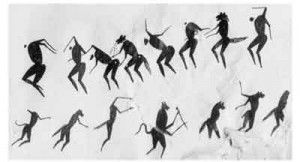
Therianthropes and trance dance from artwork painted by Kalahari artist, the late Vetkat Regopstaan Kruiper (with permission)
Ethno-archaeology: Oral narratives and rock art
The focus of my research is on the method of recording oral narratives and their link to, and possible use in, the interpretation of rock art, specifically rock engravings. Research on indigenous knowledge and artefacts falls within a contentious area of indigenous archaeology associated with colonialists’ geographic and intellectual imperialism. It is necessary for my contextual approach to include, as in the exploration of myths, the theoretical setting of ethno-archaeology within which my research takes place. In the discipline of archaeology the use of ethnography falls under what Renfrew and Bahn (1991: 339) call ‘What did they think?’ The use of ‘they’ points not only to ethical issues of ‘othering’, the negative artificial construction of two camps of cultures and the corresponding approaches of scholars and present day descendants of the artists, but also to the time gap between the artists of the past and the present (Lewis-Williams & Pearce, 2004).
The rock paintings situated in caves, shelters and on portable stones, mostly in the mountainous regions in South Africa, and rock engravings situated predominantly in the plateau areas, on boulders on hills or near rivers, date mostly from within the last few thousand years. However, small mobiliary painted stones from Apollo 11 Cave and an engraved ochre piece from Blombos Cave date from some 25 000 and up to 70 000 years ago respectively (Lewis-Williams & Pearce, 2004). This considerable antiquity complicates any attempts at interpreting the rock art by way of oral narratives, even those recorded by the earliest colonialists. Furthermore, our views and therefore theories on art, oral narrative and methodology are constantly changing (Bahn, 1998).
3.1 Early recordings and attitudes: evolutionist thinking and sympathetic magic
The Islamic incursions into Asia, Europe and Africa approximately 1 300 years ago and the interest of Western countries in foreign countries after the Middle Ages are cited historical events that precipitated an awareness of, and interest in, recording the customs of foreign cultures (Maree et al, 1997). The arrival of foreigners in ships, using horses and later ox wagons, was recorded in rock paintings and engravings by the indigenous people of South Africa (Lewis-Williams, 1983).
Travellers, adventurers, missionaries and soldiers in turn recorded aspects of African cultures in their diaries and reports prior to the formal emergence of anthropology as a science and the development of an evolutionist approach. The contribution that the drive for material rewards played in the early visitors’ hazardous journeys to the southern part of Africa was recorded by a Dominican priest in 1586:
The country is very hot, unhealthy, and prejudicial to foreigners, especially the Portuguese, who generally fall sick and die of fever; but this is not sufficient to restrain their avarice and the eagerness with which they go thither in search of the mines and riches of the country. (Dos Santos, 1586)
The ‘gaze’ of the colonialists on the ‘exotic other’ is apparent in these writings which, despite attempts to include the voice of the indigenous people, often reveal more of the attitudes and perceptions of the writers than about the cultural features they seek to portray. An example is this account of the Khoikhoi/ Khoekhoen by Christoffel Langhansz when stopping at Cape Town on his way to the Indies in 1694:
As to their religion, they have none, but live like the unreasoning brutes from day to day. Although some say of them that they reverence the moon this is not so, although it is true that by night, especially at the New Moon, they dance, or better said leap before it, and thereby howl rather than sing. But this dancing is done only for their pleasure, since leaping against their shadows and clapping their hands delights them especially, in that they see their shadows also do this; and this they continue so long as the moon shines on them, so that this dancing is thus to be considered as solely and entirely for their pleasure and amusement. (Langhansz, 1694 in Maclennan, 2003: 50)
The recording of rock art during this time was incidental and did not follow any formal methodology. The Chinese have the earliest recordings of rock art dating back to approximately 2 300 years ago by Han Fei (280-233 BC) (Bahn, 1998: 1). Mention of rock art in Europe is minimal before the 19th century.
The colonisation of the New World in the 16th century resulted in identification of rock art in South America. The link between the rock art and indigenous religion, particularly belief in ‘Quetzalcoatl’ (the feathered serpent God), caused Spanish missionaries to destroy or attempt to allocate Christian meaning to the images (Bahn, 1998: 9-10). In Ireland recordings of engravings in a burial tomb were made by Edward Lhwyd (1660-1708). The negative colonial attitudes of scholars of the time to this type of art, labelling it ‘primitive’ (Smith & Blundell, 2000:8) and of little aesthetic value, is reflected in Lhwyd’s reference to the art as ‘rudely carved’ and ‘Barbarous a sculpture’ when referring to a ‘spiral like a Snake, but without distinction of Head and Tail’ (Bahn, 1998: 6).
Charles Darwin’s Origin of the Species by Means of Natural Selection (1859) impacted not only on ideas concerning man’s origins but, as mentioned previously, on the recording of cultures. In the field of rock art, evolutionist thinking in terms of categorization from simple to complex forms led to South African rock art – especially geometric engravings – being interpreted as the idle doodlings of a primitive people (Maree et al, 1997; Lewis-Williams & Pearce, 2004) or caricatures (Bahn, 1998). The earliest recordings of rock engravings in South Africa and specifically the Northern Cape are credited to H J Wikar from Sweden on his journeys along the Gariep/Orange River in 1778. Not all early Europeans dismissed the value of the rock art in South Africa and some, such as Barrow in 1797, attempted an understanding of rock art and appreciated the realistic depictions of animals within it (Bahn, 1998). When the beauty and artistic merit of the rock art was acknowledged, some Europeans considered the art beyond the scope of the ‘primitive’ indigenous people, the San. Alternative cultures were invoked and the art was attributed to visiting ‘Caucasians’. The best known example is the ‘White Lady’ of the Brandberg (South West Africa/Namibia), so named by Breuil in 1917 (Smith & Blundell, 2000; Bahn, 1998: 62-63): ‘Heading the ‘early’ school Abbe Breuil had seen, in such paintings as the famous ‘White Lady’, early Mediterranean influences, and attributes an age of several millennia to much of the art’ (Foreword SA Arch Soc, date and author unknown (approx late 50s).
The impact on meaning attributed to rock art during the unilineal or classical phase of evolutionist thinking was the view that ‘primitive’ art was linked to ‘primitive’ religious practice, namely belief in magic. In the same way that ‘civilized’ man controls his environment with science and technology, this theory proposed that ‘primitive’ man controlled his environment with magic. This conjecture was applied to the interpretation of rock art in Europe by historic figures such as Breuil, who regarded rock art ‘primarily in terms of hunting magic’, in that the depicted animal and an associated ritual were believed to influence the outcome of the hunt (Bahn, 1998: 62; Smith & Blundell, 2000).
3.2 Early records and analysis: traditional systematic
The development of anthropology and archaeology as sciences at the beginning of the 20th century resulted in an emphasis on quantitative methodology and positivist research theory. Diffusionist theory in the late 19th and early 20th century emphasized the need to record as much data as possible before it disappeared. In archaeology and specifically the recording and analysis of rock art, a traditional, systematic approach entailed definition of artefacts in space and time. In reaction to previous subjective guesswork and ‘imaginings’ as to the significance of artefacts including rock art (Renfrew & Bahn, 1991), emphasis was placed on artefacts that could be analysed scientifically to achieve knowledge of the ‘true’ past. The excavation system of General Pitt-Rivers, developed between 1880 and 1900, influenced the recording and publication of archaeological finds (Renfrew & Bahn, 1991; Webley et al, 2000). This system required occurrence distribution maps, stratigraphic allocation and finally the assignation of artefacts or assemblages to a specific archaeological culture (Renfrew & Bahn, 1991).
Further systematic analysis of rock art in the traditional approach includes description of rock engravings in terms of place, techniques and time. Accordingly, Northern Cape rock engravings are found predominantly on ‘rocky outcrops of dolerite and diabase’ (Morris, 1998); they are divided into three techniques whereby the patina (rock crust) is removed, using another hard stone to expose ‘the lighter coloured rock beneath’ (Morris, 1998: 16), namely: fine lined (cutting with a sharp stone), scraped and pecked techniques (Dowson, 1992: 1). The three types sometimes overlap in a single site but may be assigned by archaeologists to different cultures and time periods. There is not yet unity amongst archaeologists and anthropologists regarding the culture(s) to which the rock engravers belonged. Some engravings in the Northern Cape have been dated broadly by their association with different stone tool assemblages (Morris, 1998):
The rock engravings, which are most frequently met with in the central districts of the Orange Free State and the adjoining northern parts of the Cape lying immediately to the west, also belong to this art group [Bushmen]. Its distribution coincides with that of the Upper Smithfield Industry of the Later South African Stone Culture, and the paintings and engravings are always found associated with implements of this Industry. (Schapera, 1930: 211)
Broadly, the fine line/ hairline engravings may date back up to some 8 000 years and appear to be generally older than the pecked and scraped techniques engravings, of which the oldest may extend back to approximately 3 000 years ago, with the most recent being dated 150-200 years from the present (Beaumont & Vogel, 1989; Morris, 1988; 1998; Dowson, 1992). Direct cation ratio dating of rock engravings has been attempted (Whitley & Annegarn, 1994) but the plausibility of the results has been questioned (Morris, 2002). Different engraving ‘traditions’ have been attributed to San hunter-gatherers, Khoekhoe pastoralists or Bantu-speaking farmers (Smith & Ouzman, 2004).
3.3 A Multilinear evolution, cultural ecology and rock art
Unilineal evolutionist thinking theorizing that all cultures could be graded on one path to Civilization was replaced in the 20th century with multilineal evolutionist thinking, which emphasized rather that cultures developed ‘along different paths and at different rates’ (Webley et al, 2000). This approach falls within American cultural anthropologist Frans Boas’s (1858-1942) theory of ‘historical relativism’, which called for a break away from broad unilinear evolutionary research and greater detailed focus on individual sites (Renfrew & Bahn, 1991). The ‘classification and consolidation’ of artefacts in order to record a culture was extended by the work of Marxist-influenced Gordon Childe in Europe with publications such as The Dawn of European Civilization (1925), in which he posed questions of archaeology that applied not only to the ‘what’, ‘where’ and ‘when’ of a culture’s prehistory, but included an attempt at ‘why?’. The impact of this type of research on the theory and practice of rock art research is that focus is not solely on chronology and cultural sequences but includes the historical, cultural or ecological context of their creation. The cultural historians ‘described’ rather than ‘explained’ prehistory (Webley et al, 2000: 7).
In the 1940s North American anthropologist Julian Steward and British archaeologist Graham Clark promoted the inclusion of the ecological impact as an additional factor alongside intercultural impact (Renfrew & Bahn, 1991). Towards a more ecologically inclusive approach, Clarke incorporated the investigative skills of specialists in animal bones and plant remains to develop the archaeological record. This type of approach is reflected in South African rock art through an emphasis on the inclusion of rock art as part of the archaeological record: ‘after all, the art is a part of the culture of the peoples who created it, and must be studied along with bones and stones, pottery, houses and graves’ (Foreword SA Arch Soc, date and author unknown [approx late 50s]). Northern Cape rock art research “in the 1980’s was very much concerned with seeing rock art as part of the broader archaeological record (cf. Inskeep, Parkington), and I still believe this to be a crucial perspective” (Personal correspondence, D. Morris 2009).
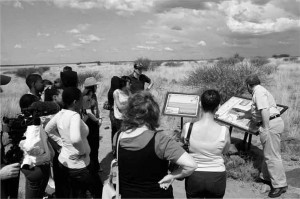
Fig.3.1 Mc Gregor Museum archaeologist, David Morris, shares the historical context of Wildebeestkuil rock engraving site with visiting students. Photograph: K-S Lange (with permission)
In 1948 WW Taylor published A Study of Archaeology wherein he opposed the culture-historical approach with his call for a cultural anthropological methodology, which echoed contemporary ethnography (Webley et al, 2000). The dissatisfaction with older forms of archaeological research culminated in the 1960s with the formation of a much more positivist ‘New Archaeology’.
3.3B Quantitative studies: search for patterns and rock art
In South Africa during the 1950s the theory of interpretation of rock art included ‘art for art’s sake’; that is, that the rock art was created with no specific meaning but purely for recreational purposes. Unlike in the colonial approach, the aesthetic merits of the art were recognised:
The aesthetic value of such paintings is widely appreciated and has already been greatly exploited by the makers of fabrics, ashtrays, and beer mugs[…] Carefully protected and properly published, it may provide a wealth of information for those interested in Africa’s past, and a source of pleasure for generations to come. (Foreword SA Arch Soc, date and author unknown (approx late 50s)
But no symbolic meaning was attached to the images, as illustrated in The Rock Paintings in Africa, published by The South African Archaeological Society (date unknown [approx. late 1950’s]. The images of the rock art are grouped geographically but no interpretation is imposed in the caption, for example:
Human-headed seals or fishes at Ezeljachtspoort, George district, Cape Province. A painting 10 ¼ inches (26 cm) in horizontal diameter, generally known as the Mermaid Scene, and probably represents a local legend linked with the sea. (Plate XXXV Copied by Miss M. Wilman. Vol. ii, No. 7)
An explanation for this lack of interpretation is given as follows: ‘partly because it is thought that this is an exercise in which readers may wish to indulge according to their own tastes and theories without interference from the editor!’ (Foreword SA Arch Soc, date and author unknown). Although meaning was not attributed, the significance of motivation and examples of possible inspirations for the art were proposed:
It is important to attempt to arrive at the motives underlying the art […] there seem to be a variety of motives. Hunting magic may well be one, but it is less easy to be sure than in Europe. Some, such as the lone piper, may well be simply the expression of artistic feelings, but elsewhere there is good reason to believe that some paintings are true pictograms recording particular events in the life of a group of people. Others are almost certainly connected with initiation centres and ceremonies. (Foreword SA Arch Soc, date and author unknown)
An emphasis on quantitative studies was influenced by scientific discoveries in the mid 20th century and a dissatisfaction with the lack of scientific procedures as expressed by the South African Archaeological Society in the above-mentioned publication regarding the dating of rock art: ‘There are two main schools of thought (how nice it would be to replace them with volumes of facts!)’ (Foreword SA Arch Soc, date and author unknown [approx late 50s]).
Quantitative studies in rock art meant further categorization according to details typical of a structuralist approach, whereby understanding is sought within the break-down into smaller segments. The styles of engraving were divided further than the categories mentioned earlier (such as technique) into the type of images depicted; that is, representational and non-representational or geometrics. Representational rock engravings were also categorized into either specific animals as opposed to humans, or into types of animals such as rodents, mammals etc; the frequency with which each of these appeared on a site was noted, for example, in the records of rock engravings of South Africa by G J Fock in the 1960s and 1970s (Smith & Blundell, 2000).
The development of scientific dating, such as dendrochronology in 1929 by A E Douglas and radio carbon dating by W Libby in 1949, shifted the emphasis in archaeology from merely descriptive and inductive approaches (that is, looking for generalizations from specifics) to a more deductive approach (that is, explaining processes, which could now be dated more securely, rather than just describing them). This approach was led by Lewis Binford and other American archaeologists in the 1960s and named ‘New Archaeology’. This type of archaeology, also known as processual archaeology, called for a process in archaeology and therefore rock art research that required: ‘the formulation of a hypothesis and then testing it through a carefully designed research project’. Research, however, was still situated within ‘culture historical reconstruction’ (Webley et al, 2000: 10).
3.4 Multiple voices and rock art
The influence of post-structural semiotics and the unstable sign or multiple meanings impacted rock art research theory with the appearance of several new theoretical approaches. The functional and evolutionary approaches discussed previously were rejected in favour of a more human based approach. Post-processual archaeology emphasized people as:
knowledgeable actors who construct, change and manipulate their social worlds. Meaning is more important than materialism and is always actively created, mediated in relation to interests and social strategies. (Binneman, 2000: 45)
In South African rock art though ‘the history of rock art research does not simply follow that of archeaology’ (Ouzman, Sven 2007), as in other parts of the world, research approaches that emphasized quantitative processes were not discontinued but were found to be inadequate: ‘counting and listing require enormous amounts of time and labour, and at the end of the day do not reveal anything much about meaning – they merely provide the raw material on which hypotheses can be based’ (Bahn, 1998: 68). New approaches in archaeology are reflected in some South African rock art research, where bridging the gap between the sign and relative interpretation is attempted by means of emphasis on universal physiological traits, as in the psychoneurological theory of Lewis-Williams and Dowson (1989) or emphasis on landscape context, for example, Deacon (1994). Solomon (2006) developed a research process intended to reveal the ideology behind the sign, with an emphasis on post-colonial theory including feminism and the rights of indigenous people. There is new focus on intertextuality and pluralism either by emphasizing the multiplicity or ‘multivocality’ behind the text or through inclusion of multiple voices, especially the voice of indigenous people and the marginalized, as in the work of Morris (2010 in press).
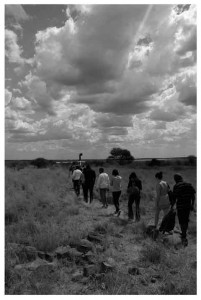
Fig. 3.2 – The ‘power of the place’ Wildebeestkuil rock engraving site. Photograph: K-S Lange (with permission)
3.5 Psychoneurological/ Shamanistic model of rock art
Archaeology differs from historical studies in that it is not only a discipline of the humanities but also a science, and as such requires scientific investigation of material traces from the past (a past which extends right up to the present) – investigation that emphasizes the importance of the archaeologist’s analysis as much as it does the ‘instruments of a laboratory’ (Renfrew & Bahn, 1991: 10).
Lewis-Williams and Dowson made use of ‘controlled experiments, observations of contemporary hunter-gatherers […] and formulations’ that ‘translated the contemporary observations of static material things, and quite literally, translated them into statements about the dynamics of past ways of life’ (Fagan, 1994:26). Lewis- William’s breakthrough in rock art interpretation was ten years before Dowson collaborated with him (Ouzman, Sven 2007). His work ‘came in via structural Marxism, an offshoot of especially Childe’s culture history’ (Ouzman, Sven 2007). The formulation used by Lewis-Williams and Dowson, initially for the interpretation of South African rock art but later attributed international relevance, is known as the neuropsychological or shamanistic model of rock art interpretation (Lewis-Williams, 1980, 1982, 1983, 1988; Lewis-Williams & Loubser, 1986; Lewis-Williams & Dowson, 1989).
The focus of this research requires exploring the neuropsychological model in some detail, given its marked influence on contemporary rock art interpretation, whether in terms of inclusion or opposition:
The ground breaking work of David Lewis-Williams not only introduced a new paradigm in our understanding of San rock art, but an increasing number of researchers utilised aspects of this shamanistic model into their own work. However, the absence of any substantial body of southern-San ethnography cast doubt for some workers on aspects of the shamanistic model, which was essentially based on Kalahari San ethnography, intertwined with historical records of the southern San. (Prins, 1999: 47)
Contemporary interpretative archaeology, according to Prins, often exists within a positivist view of reality (one true, knowable, reality) and ‘is still practiced largely along the empirical and scientistic frameworks of the 1960s and 70s’ (Prins, 1999: 43). Lewis-Williams & Dowson made use of two ‘interlocking approaches’ of processual archaeology, namely ‘ethno-archaeology’ and ‘experimental’ archaeology (Fagan, 1994: 328). Rock art research focused on the meaning the art held for the artists (Lewis-Williams & Dowson, 1989).
Ethnography became ‘the key to the art’ when archaeologists turned to indigenous people’s beliefs for understanding of rock art (Smith & Blundell, 2000: 11). The early diaries of travellers, missionaries and explorers provided the first written records of the customs of the Khoisan speaking people of Southern Africa. These recordings were limited by the majority of these first writers not speaking the indigenous languages, as well as by their context and their colonial prejudices, specifically regarding the religious and spiritual beliefs of the indigenous people of South Africa.
The necessity of understanding the religious and spiritual beliefs of a people in order to understand their art is communicated by Lewis-Williams and Dowson through the analogy of Leonardo da Vinci’s artwork in The Last Supper. Quantification of images present in the artwork does not bring the viewer closer to understanding the significance of the artwork within a Western Christian context, neither does an aesthetic (discussion of the use of colour and composition) or narrative (the art as a record of the customs, dress and so on of the time) description of the artwork. Knowledge of the role of Christ, the Eucharist (the Last Supper) and Christian or Western symbolism transforms the artwork from being merely a record of a group of men eating to the representation of an important Christian ritual (Lewis-Williams & Dowson, 1989; Lewis-Williams, 1990).
The neuropsychological model accommodates the religious and spiritual beliefs of the rock artists, acknowledging the integral role of spiritual life in everyday activities and the lack of compartmentalization between the sacred and the secular (Lewis-Williams & Dowson, 1989). Lewis-Williams and Dowson used the following sources to research these beliefs: recordings made in 1873 by Natal Government magistrate Joseph Millard Orpen of Bushman guide Quing’s stories and explanations of rock paintings in Lesotho; the 1870s records of German philologist Dr Wilhelm Heinrich Immanual Bleek and his sister-in-law, Lucy Lloyd, based on the testimony of Southern /Xam Bushmen prisoners in Cape Town; information on the ingredients used in rock painting from Mapote, a Basuto man whose father Moorosi had painted in the caves as recorded by Marion Walsham How in the 1930s (How, 1970); the American Marshall family’s written and filmed ethnographic records of the Kalahari !Kung in the1950s (Smith & Blundell, 2000: 12); as well as:
…research done on the Kalahari Bushmen during the last three decades. Writers such as […] Mathias Guenther, Philip Tobias, Alan Barnard, Marjorie Shostak, Richard Katz, Nancy Howell, Patricia Draper, George Silbauer and Polly Wiessner. (Lewis-Williams & Dowson, 1989: 28)
Criticism mentioned earlier by Prins of the use of Kalahari !Kung ethnography for interpretation of art by a completely different San/Bushmen language group in South Africa, namely the /Xam, was addressed through emphasis on the similar ‘ritual practices’ of the two peoples (Smith & Blundell, 2000: 12):
San beliefs and rituals still form an important aspect of their lives. The basic structure and metaphors in this belief system have strong similarities with those used by the /Xam and Quing and it is these that have shed welcome light on the rock art. And because these similarities can be identified from information gathered a century ago and several thousand kilometres apart, we feel confident about using the general principles of the beliefs and rituals to interpret the rock art. (Deacon & Deacon, 1999:169)
Further ethnography on the southern San was introduced into the archaeological research arena by Prins and Jolly in 1986:
With the publication of two articles relating to the discovery of a first generation southern San descendant, known as M, with authentic knowledge of rock art production and symbology (Jolly, 1986; Lewis-Williams, 1986). M’s father Lindiso was probably the last known San painter, and he passed on some of his knowledge to M (Prins, 1994). Given developments in rock art research at the time it is not surprising that M’s testimonies were largely utilised to validify and to complement aspects of the shamanistic model or the trance-hypothesis, as it was then known. (Prins. 1999: 47)
Lewis-Williams’s current work includes reference also to the ethnographic research of Megan Biesele in the Kalahari, specifically regarding maidens and ‘metaphors of transition’ (Lewis-Williams & Pearce, 2004: 160).
3.6 Aspects of the neuropsychological model
The neuropsychological model proposes that rock art was painted by medicine men or shamans and that the content of the rock art largely comprises a record of the shamans’ trance hallucinations. The neuropsychological model bases its hypothesis on three aspects of research, namely: Western neuropsychological laboratory experimentation on the effects of mind altering drugs on patients and the stages of ‘trance’; ethnography of the trance or curing dance from the Kalahari !Kung, and the prominent role in trance dance of the eland in /Xam and !Kung spiritual beliefs and rituals.
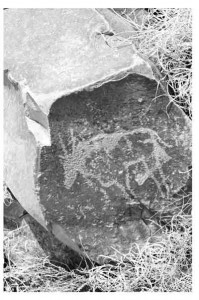
Fig.3.3 Eland rock engraving at Wildebeestkuil rock engraving site. Photograph: K-S Lange (with permission)
The work of Patricia Vinnicombe in 1976 is cited by Lewis-Williams as a turning point in rock art research, as she (along with Tim Maggs in the same year) revealed the significant contribution of breaking away from the narrative approach to rock art research. Quantification indicated the eland as the most frequently depicted animal in most parts of South Africa (Lewis-Williams, 1990). Ethnographic collections in South Africa revealed the eland as an integral part of San/Bushman rituals and thought (Smith & Blundell, 2000). As mentioned previously, multiple meanings (polysemy) influenced the interpretation of rock art in the 1970s, particularly with regard to the frequent depiction of the eland in rock paintings and engravings in southern Africa (Lewis-Williams, 1990). Narrative interpretations had previously read the depictions of animals in specific places as indication of the prevalence of that type of animal within that area, but in the 1970s the influence of research into the beliefs of the artists led to the eland gaining multiple meanings, including religious symbolic status.
Not only were words indicating respect attributed to the eland by the San/Bushman, but sometimes the strength of naming it was considered too strong and therefore a taboo. Lorna Marshall mentioned the !Kung word n/om for the power or energy that certain animals and people contain at certain stages of their lives. Like electricity, the potency could be useful or dangerous. Shamans and the eland (and parts of the eland such as its fat and blood) were considered to be full of potency, which the shaman was required to control ‘for the good of all people’ (Lewis-Williams & Dowson, 1989:32). The eland was part of the most important rituals of the San/Bushmen’s lives, namely: the boys’ hunting rituals, the girls’ puberty rituals or Eland Bull dance, the curing and rainmaking dances. All these rituals were important for the unity of the people and therefore the eland brought with it connotations of ‘fatness, well-being and rain’ (Lewis-Williams & Dowson, 1989: 82). In the initiation rituals the fat of the eland was used on the initiates (Lewis-Williams, 1990) and in the paintings the eland blood was used in the ingredients (How, 1970).
3.6B The trance dance
A ritual central to the neuropsychological model of rock art interpretation is the trance or curing dance (Deacon & Deacon, 1999). This dance is led by medicine persons in the San/Bushmen groups. Lewis-Williams and other archaeologists and anthropologists name these spiritual leaders of the San/Bushman, ‘shamans’:
‘Shaman’ is a Tungus word from central Asia. It has been accepted in the anthropological literature to mean someone in a hunter-gatherer society who enters a trance in order to heal people, foretell the future, control the weather,ensure good hunting, and so forth. (Lewis-Williams & Dowson, 1989: 30-31)
In the 1830s, the French Protestant missionary Thomas Arbousset described a dance called ‘the dance of blood’ because of the number of nose bleeds during the dance (Maclennan, 2003; Smith & Blundell, 2000). The trance dance is performed in order to ‘obtain supernatural power from God’, which is mainly used to heal people, as well as for rain making, game control and group cohesion (Deacon & Deacon, 1999: 168). Unlike shamans in other parts of the world who do not participate in everyday life, the Bushman shamans are non-privileged ‘ordinary people’ with approximately half the men and a third of women in a particular group claiming to be shamans (Lewis-Williams & Dowson, 1989:31; Deacon & Deacon, 1999). Ethnography recorded from Quing by Orpen refers to an apprenticeship training whereby experienced trancers taught new pupils, over a few years, the techniques needed for trancing, and imparted potency (Deacon & Deacon, 1999).
The trance dance of the Kalahari !Kung and !Xo, like other traditional San/Bushman dances, usually takes place around a central fire with the women sitting and clapping the rhythm and men and women dancing around the women, or with the dancers inside with the clapping group standing or sitting around them (Marshall Thomas, 1959; Lewis-Williams & Dowson, 1989; Lange et al, 2003b).
Shamans traditionally wear a kaross around their shoulders for a trance dance and have a stick in one hand and often a fly whisk, which is made from the tail of a buck and used to ‘remove the arrow of sickness’, in the other hand (Deacon & Deacon, 1999:173). The Kalahari !Kung and !Xo dancers tie rattles made from dried cocoons and small pebbles, pieces of ostrich egg shell or camel thorn tree seeds around their legs (Lewis-Williams & Dowson, 1989; Lange et al, 2003b). The /Xam are recorded as also making rattles out of ‘dried springbok ears’ (Lewis-Williams & Dowson, 1989: 44). On their heads, the dancers often wear headdresses made of animal skin and designed with animal qualities such as horns or ears and a tail (Lewis-Williams, 1990).
The intense dancing, singing, clapping, rattles and stamping continue for hours until the shamans, aided by ‘intense concentration and hyperventilation’, enter a mind-altered state of trance. Physical indicators of the shaman having entered this state recorded by Orpen include bending over, falling down and blood running from the nose (Deacon & Deacon, 1999: 170-171). During this state, n/om potency builds up painfully in the body as the dancer gasps for breath, sweats and trembles, feeling hairs standing up on the body (Lee & Woodhouse, 1970). Metaphors used for this experience include dying, drowning and flying (Lewis-Williams & Dowson, 1989).
Depending on the dance, the shaman can harness the potency in different ways; for example, during a trance dance the shaman would, trembling, place hands on a sick person to draw out the illness. In rainmaking ceremonies, when the shaman collapses, his spirit leaves his body to harness a rain animal and bring it across the mountains and veld where, on its killing, the blood or milk would provide rain. These scenes were depicted in rock paintings in which Lewis-Williams and Dowson read the eland, the favourite animal of the San/Bushman trickster-God /Kaggen (Deacon & Deacon 1999), as mirroring the shaman in trance with buckled crossed knees, blood from the nose and potency indicated by continuous or dotted lines emitted from behind the neck (Lewis-Williams, 1990). Shamans drawn in association with eland, in postures such as touching their tails, are read as drawing strength from the potent animal. Lewis-Williams and Dowson regard the eland as a metaphor for the trancing shaman; that is, a symbol of entering an altered state of consciousness, entering the spirit world with the rock face as the veil between the real and the spiritual world (Lewis-Williams & Dowson, 1990).
The depiction in rock art of therianthropes – creatures with animal and human features – is also read in the trance hypothesis as an indication of an altered state of consciousness and therefore supportive of the shamanistic model. The reason for this attribution is discussed below.

Fig.3.4 Therianthropes and trance dance from artwork painted by Kalahari artist, the late Vetkat Regopstaan Kruiper (with permission)
3.6C Neuropsychological research
Lewis-Williams insists that neuropsychological research was not used to ‘show that the art is the product of altered states of consciousness’, as he believed the ethnography had already proved this. Neuropsychological research was used for further understanding of rock art as depictions of ‘visions and experiences of shamans who entered trance’ (Lewis-Williams, 1990: 55-56). This was particularly relevant for Lewis-Williams and Dowson’s (1988) interpretation of geometrics.
The neuropsychological research approach used by Lewis-Williams and Dowson was applied by Siegel to ‘the experiences of people from a variety of ethnic backgrounds in different countries around the world who have taken hallucinatory drugs’ (Deacon & Deacon, 1999: 172). The laboratory experiments made use of ‘hallucinogenic drugs such as LSD’ (Lewis-Williams, 1990: 55). The experiments noted that all subjects went through three stages: a first stage of seeing ‘entoptics’ (geometric shapes); a second stage of trying to make sense of these entoptics according to the cultural context of the subject, for example: a u-shape interpreted as a boat; a third stage where the subject loses a grip on his sense of reality and entoptics are no longer important. Images seen are no longer like but rather are, as the subject hallucinates ‘animals, monsters and other things with a powerful emotional content’ (Lewis-Williams, 1990: 56-57).
The third stage was used to explain the depiction of therianthropes within a trance hypothesis. The shamans depicted animals that they experienced themselves becoming (Lewis-Williams, 1990). (This aspect and others mentioned previously relating to states of altered consciousness and the production of rock art will be explored further in the discussion of rock engravings in the research area.) Other sensations related by the subjects such as lengthening and extra digits were also used to interpret rock art that had fallen outside of the narrative approach (Lewis-Williams & Dowson, 1989). Lewis-Williams noted the greater concentration of entoptics in rock engravings as opposed to rock paintings but, in the 1990s, could only speculate as to the significance of this phenomenon (Lewis-Williams, 1990).
—
About the author
Mary Lange (MA), is chairperson of ARROW SA: Art, Culture & Heritage for Peace (Reg 088 058 NPO) affiliated to the international arts for peace organisation INDRA CONGRESS (previously ARROW: Art a Resource for Reconciliation Over the World). Her research interests include oral narratives, visual anthropology, and theatre in development. Lange is a postgraduate supervisor and undergraduate lecturer with The Centre for Communication, Media and Society (CCMS), University of KwaZulu-Natal (UKZN). ARROWSA is a CCMS, UKZN research affiliate. Lange is multi-talented, a Culture and Heritage programme facilitator who does drama, a visual anthropologist who educates students in the field. She is currently directing a rock art project in the Northern Cape.
From: Mary Lange – Water Stories and Rock Engravings- Eiland Women at the Kalahari Edge
Rozenberg Publishers 2011 – ISBN 978 90 361 0245 2
Comments
One Response to “Rock Art Research in South Africa”
Leave a Reply


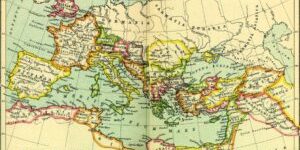

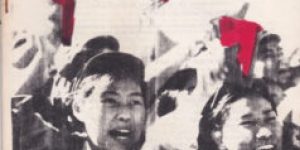
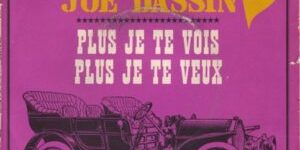
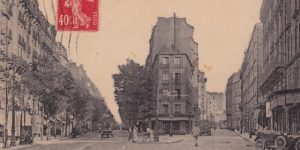
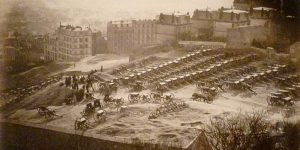

December 21st, 2018 @ 4:48 pm
Dear Prof Lange
Have you any more recent papers on San rock art?
Thank you
Marian